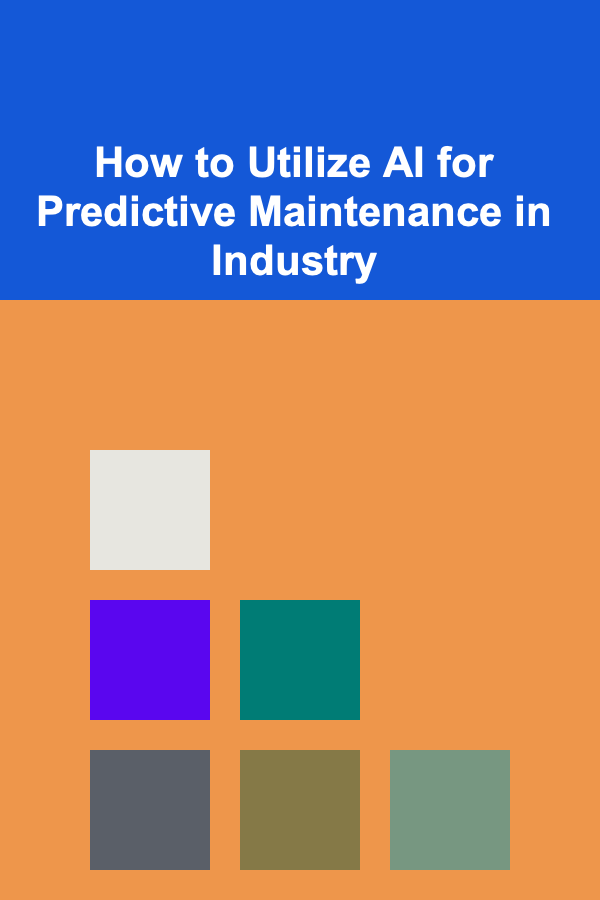
How to Utilize AI for Predictive Maintenance in Industry
ebook include PDF & Audio bundle (Micro Guide)
$12.99$6.99
Limited Time Offer! Order within the next:

The rapid advancement of Artificial Intelligence (AI) has revolutionized numerous industries, providing solutions to problems that were previously thought insurmountable. One of the most significant applications of AI is in predictive maintenance, an area where it helps industries reduce downtime, optimize equipment efficiency, and reduce operational costs. Predictive maintenance refers to the process of monitoring the health of equipment and machinery to predict failures before they occur, allowing for timely interventions to prevent unscheduled breakdowns. This shift from reactive to proactive maintenance is made possible through AI, which enables industries to leverage vast amounts of data for better decision-making.
This article delves into the utilization of AI for predictive maintenance in industry, covering its importance, how it works, the technologies involved, and the benefits it brings to manufacturing, energy, transportation, and other sectors.
The Importance of Predictive Maintenance
Traditionally, industrial maintenance was carried out in two primary ways: reactive and preventive. Reactive maintenance involves fixing machines after they break down, often leading to costly repairs and production losses. On the other hand, preventive maintenance schedules regular maintenance regardless of the machine's condition, potentially leading to unnecessary downtime or missed opportunities to optimize operations.
Predictive maintenance, however, is different. It uses data and advanced analytics to predict when a piece of equipment is likely to fail, allowing organizations to perform maintenance only when necessary. This proactive approach minimizes downtime, reduces maintenance costs, extends the lifespan of equipment, and improves overall efficiency.
The integration of AI into predictive maintenance takes this concept a step further by automating the data analysis process, uncovering patterns and correlations that would be difficult for human engineers to detect. By using AI, industries can achieve a level of precision and optimization that is essential for maintaining competitiveness in the modern market.
How AI Works in Predictive Maintenance
At the core of AI-driven predictive maintenance lies data---lots of it. AI systems collect and analyze data from sensors embedded in machinery, operational logs, and historical maintenance records. Through machine learning algorithms, AI systems can analyze this data to detect early warning signs of potential failures, such as unusual vibrations, temperature fluctuations, or unexpected wear patterns. The process can be broken down into several stages:
1. Data Collection
The first step in utilizing AI for predictive maintenance is gathering data from the equipment. Industrial machines are equipped with sensors that monitor various parameters, such as temperature, vibration, pressure, and sound. These sensors generate massive amounts of data in real-time. In addition to sensor data, other relevant data sources such as historical maintenance records, production data, and external factors like weather conditions may also be collected.
The key to success in predictive maintenance is the accurate and continuous collection of this data. The more data that can be collected, the more accurate the AI model becomes. Edge computing is often used to process data closer to the machine, which allows for faster insights and reduces the need for extensive data transfer.
2. Data Preprocessing and Feature Engineering
Once data is collected, it needs to be cleaned and preprocessed. Raw sensor data often contains noise or irrelevant information that can hinder the performance of machine learning algorithms. Data preprocessing involves filtering out this noise, handling missing values, and normalizing the data to ensure consistency.
Feature engineering is the process of selecting and transforming raw data into meaningful features that can be used by machine learning models. In predictive maintenance, this might involve extracting relevant features like trends, cycles, and anomalies in the data. This step is crucial because the quality of the features will directly impact the performance of the AI model.
3. Model Training and Development
The heart of AI in predictive maintenance is the machine learning model itself. Using the cleaned and engineered data, the AI system is trained to identify patterns that correlate with equipment failure. Several machine learning techniques can be employed in predictive maintenance, including:
- Supervised Learning: This involves training the model using labeled data, where the outcomes (e.g., machine failure or no failure) are already known. The model learns from this data and generalizes to predict future failures.
- Unsupervised Learning: In cases where labeled data is unavailable, unsupervised learning can be used. Here, the model looks for patterns and clusters in the data without explicit guidance. It may identify anomalies or behaviors that suggest a failure is imminent.
- Reinforcement Learning: This approach involves training the model by rewarding it for making correct predictions and penalizing it for incorrect ones. It is used to continuously improve the model as more data becomes available.
Once the model is trained, it needs to be validated and tested to ensure that it can predict failures accurately. This often involves splitting the data into training and test datasets to evaluate the model's performance on unseen data.
4. Real-Time Monitoring and Alerts
Once deployed, the AI system continuously monitors the health of the equipment in real-time. It compares the incoming data to the patterns it has learned during training. When the system detects any signs of potential failure, such as abnormal vibration or a rise in temperature, it generates an alert for the maintenance team.
AI-powered systems can also prioritize alerts based on the severity of the issue, ensuring that the most critical problems are addressed first. These real-time insights help maintenance teams make informed decisions, which leads to more effective and timely maintenance interventions.
5. Predictive Insights and Maintenance Scheduling
The AI system does not just provide alerts; it also offers predictive insights into when a failure is likely to occur. By analyzing historical data, the AI can estimate the remaining useful life (RUL) of a piece of equipment, allowing maintenance teams to schedule maintenance activities in advance. This reduces downtime by ensuring that maintenance is performed just before a failure is likely to occur, rather than after the fact.
Predictive insights help companies move from a reactive to a more proactive maintenance approach, leading to a more optimized and cost-effective operation.
Technologies Enabling AI in Predictive Maintenance
Several key technologies play a crucial role in enabling AI-driven predictive maintenance:
1. Internet of Things (IoT)
IoT devices, including sensors and actuators, are essential for gathering data from equipment. These devices continuously monitor machine health and send data to a central system for analysis. The widespread adoption of IoT in industry has made it easier than ever to collect vast amounts of real-time data, making predictive maintenance possible on a large scale.
2. Machine Learning and Deep Learning
Machine learning algorithms, particularly those based on deep learning, are essential for analyzing complex data and making predictions. Deep learning models, which are a subset of machine learning, are particularly useful in predictive maintenance due to their ability to handle large datasets and learn complex patterns.
Convolutional Neural Networks (CNNs), Recurrent Neural Networks (RNNs), and Long Short-Term Memory (LSTM) networks are often used to process sensor data, identify trends, and predict failures.
3. Cloud Computing
Cloud computing provides the infrastructure needed to store, process, and analyze the massive amounts of data generated by IoT devices. It allows AI models to scale easily, enabling industries to handle data from thousands of machines simultaneously. Cloud platforms also offer the computing power necessary to run advanced machine learning models, making AI-driven predictive maintenance feasible even for smaller companies.
4. Edge Computing
Edge computing refers to the processing of data closer to where it is generated, rather than sending it all to the cloud. This is particularly useful in predictive maintenance, as it enables real-time decision-making and reduces latency. Edge computing allows for faster insights and alerts, ensuring that maintenance teams can act quickly when a potential failure is detected.
Benefits of AI-Driven Predictive Maintenance
Implementing AI for predictive maintenance can bring numerous benefits to industries, including:
1. Reduced Downtime
By predicting failures before they happen, AI can help reduce unplanned downtime. Predictive maintenance ensures that equipment is serviced at the right time, preventing unexpected breakdowns that could lead to costly production halts.
2. Lower Maintenance Costs
Predictive maintenance can significantly reduce the costs associated with traditional maintenance practices. By performing maintenance only when necessary, companies can avoid the costs of unnecessary preventive maintenance and reduce the frequency of expensive repairs resulting from unexpected breakdowns.
3. Improved Equipment Lifespan
By catching issues early, AI can help extend the life of equipment. Preventing major failures through timely interventions ensures that machinery operates more efficiently for longer, maximizing the return on investment.
4. Increased Operational Efficiency
AI-driven predictive maintenance improves operational efficiency by ensuring that machines run at optimal performance levels. It also helps in planning maintenance activities during scheduled downtime, minimizing the impact on production schedules.
5. Enhanced Safety
Predictive maintenance can also improve safety by identifying potential equipment failures that could pose a hazard to workers. Addressing issues before they lead to catastrophic failures reduces the risk of accidents and injuries on the shop floor.
Challenges in Implementing AI for Predictive Maintenance
Despite its numerous benefits, the implementation of AI for predictive maintenance also comes with challenges. These include:
- Data Quality and Availability: Predictive maintenance relies on high-quality data. Inconsistent or insufficient data can lead to inaccurate predictions, reducing the effectiveness of the AI system.
- Cost of Implementation: Setting up an AI-driven predictive maintenance system requires a significant investment in sensors, computing infrastructure, and training. Smaller companies may struggle with the initial costs.
- Integration with Legacy Systems: Many industries still use older equipment that may not be compatible with modern AI-driven systems. Integrating AI with legacy systems can be complex and costly.
- Skill Gaps: Implementing AI solutions requires specialized knowledge in data science, machine learning, and industrial operations. Companies may face challenges in recruiting or training staff with the necessary expertise.
Conclusion
AI-powered predictive maintenance is transforming industries by enabling more efficient, cost-effective, and proactive maintenance practices. Through data collection, machine learning, and advanced analytics, AI systems can predict equipment failures, optimize maintenance schedules, and reduce downtime, ultimately leading to significant operational improvements. While there are challenges to its implementation, the benefits far outweigh the costs, making AI-driven predictive maintenance a key technology for future industrial operations. As AI continues to evolve, its role in predictive maintenance will only become more critical in helping industries maintain competitiveness in a fast-changing world.

Budget-Friendly and Fun: Top Affordable Family Activities to Try Today
Read More
How to Make Money with Deep Learning as a Freelance Developer
Read More
How to Set Up a Clear and Fair Tenant Screening Process
Read More
How to Use Hooks and Pegboards for Extra Storage Space
Read More
The SEO Copywriter's Guide: Crafting Content for Search Engine Success
Read More
How to Conduct a Workday Audit Checklist
Read MoreOther Products

Budget-Friendly and Fun: Top Affordable Family Activities to Try Today
Read More
How to Make Money with Deep Learning as a Freelance Developer
Read More
How to Set Up a Clear and Fair Tenant Screening Process
Read More
How to Use Hooks and Pegboards for Extra Storage Space
Read More
The SEO Copywriter's Guide: Crafting Content for Search Engine Success
Read More